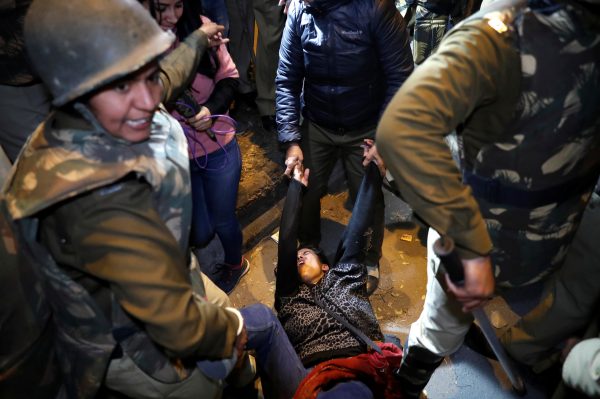This year, the two governments plan to sign a logistics-sharing agreement that will allow for reciprocal military access to facilities and operational support. Potential agreements for information-sharing and maritime cooperation will facilitate greater military cooperation in the Indian Ocean. A memorandum of understanding to increase collaboration in the research and development of new defence technologies is also in the works.
By boosting defence cooperation with India, Australia hopes to limit the extent to which China will dominate the Indo-Pacific region as its political and economic power grows. Underpinning these hopes are assumptions that India and Australia share democratic values and have a similar conception of a rules-based order in the Indo-Pacific.
The days of making easy distinctions between security and economics and a democratic India and authoritarian China, however, are long gone. India is changing rapidly in ways that may push it towards rather than away from China.
Economically, India is facing a major growth slowdown with entrenched declines in consumption, private investment and exports, and falling tax revenue. Bolstering the few dynamic sectors of the Indian economy — such as e-commerce, telecommunications and technology start-ups — will become increasingly important. These are areas in which China is deeply embedded.
A case in point concerns Huawei. Australia has excluded Huawei from the construction of its 5G network on security grounds. But the Indian government recently announced that Huawei will be allowed to take part in India’s 5G network trials. India’s major telecommunications carriers — Airtel, Reliance Jio and Vodafone — use Chinese technology extensively, considering it to be both cheaper and more technically advanced than the options.
The Army and the Swadeshi Jagran Manch (SJM) — a group linked to the ruling Bharatiya Janata Party’s affiliate, the Rashtriya Swayamsevak Sangh — have both objected to Huawei’s participation in 5G trials over security concerns. But the SJM’s economic nationalist views have only ever had a modest impact on policy. Setting up a domestic 5G network requires sustained government funding to develop locally-built equipment like semiconductor chips. So far, this has not been forthcoming.
Chinese products also dominate India’s booming smartphone market due to lower price points and distinctive design features. India is the biggest market for the Chinese phone manufacturer Xiaomi, which recently stepped up local production. Xiaomi is one of the companies the Trump administration accuses of being enmeshed with the Chinese government and military.
Chinese companies like Alibaba and Tencent are also major investors in India’s technology start-ups. Alibaba is the biggest shareholder in Paytm, an Indian financial technology and e-commerce company whose digital payments system benefited from Modi’s demonetisation policy.
China is also a leader in technology that can be used for surveillance such as facial recognition. This is becoming important for a more authoritarian Modi government. India is a growing market for the Chinese artificial intelligence-driven surveillance camera maker Hikvision, another company banned by the United States.
India is rapidly changing politically. Recent events, such as the introduction of religious criterion to its citizenship laws and violent crackdowns on protests, call into doubt the government’s commitment to secular democracy. As the ruling regime intensifies its ideologically-driven policy agenda and its bid for political domination, India enters a cycle of protest and violence.
In this period of political flux, China appears to be becoming a model for the Modi regime. India’s Foreign Minister Subramanyam Jaishankar recently dismissed the protests and praised China for having ‘the mindset to decisively address its current issues’.
The admiration appears to be mutual. The People’s Daily has pointed to India’s repeated use of internet blackouts across the country as an example of how sovereign nations should respond in a state of emergency. Many of India’s internet shutdowns were undertaken in the name of public safety. In the Kashmir Valley, the internet was completely blocked for six months. It continues to be heavily restricted.
This is despite the Supreme Court’s declaring that indefinite internet curbs are unconstitutional and despite the absence of major violence in Jammu and Kashmir. It reflects the government’s lack of confidence in its ability to deal with the fall-out of its move to strip the state of its constitutionally-guaranteed political autonomy.
The ongoing protests in India against the citizenship laws are unlikely to result in the regime changing its behaviour. Anti-pluralism and intolerance for dissent are intrinsic to its current Hindu nationalist politics. These values are now surfacing in India’s foreign policy. In a visit to the United States last month, Jaishankar cancelled a meeting with the House Foreign Affairs Committee to avoid Pramila Jayapal, a congresswoman critical of India’s policies in Kashmir.
The Australian government has remained scrupulously quiet about the recent violence in India, which has killed 25 people — even while it has repeatedly criticised Hong Kong authorities for violence resulting in two deaths. Australia has said nothing of the indefinite detention of political leaders and civilians in Kashmir. To the contrary, before embarking on her visit to the Raisina Dialogue in New Delhi, Australia’s Foreign Minister Marise Payne recycled the usual refrain that India and Australia are natural partners that share ‘common values based on democracy’.
This whitewashing is unsustainable. Australia will need to find a way to acknowledge and deal with the changes taking place in India. Increasing Australia’s India literacy has never been more pressing.
Priya Chacko is a Senior Lecturer in international politics at the Department of Politics and International Studies at the University of Adelaide.

